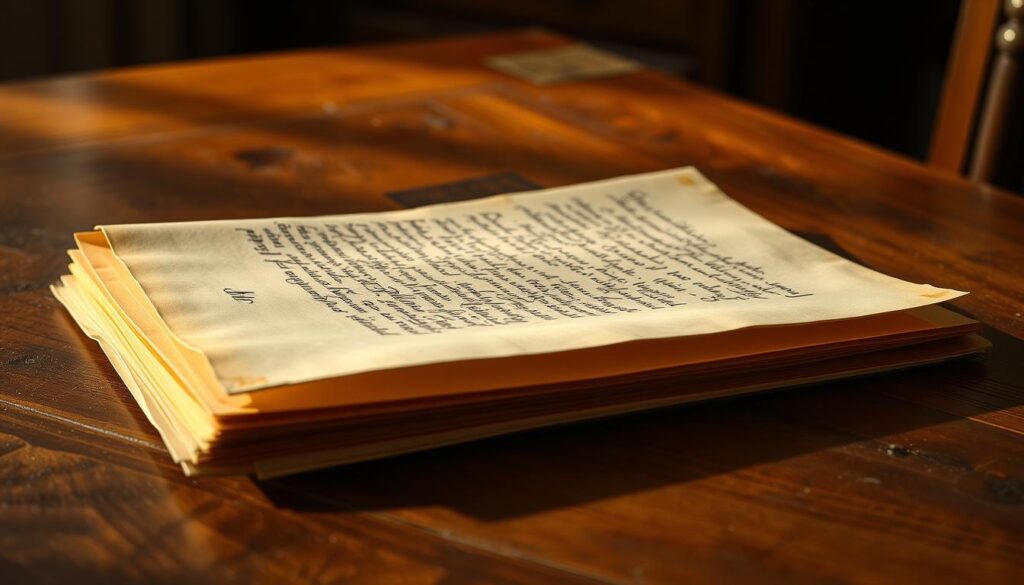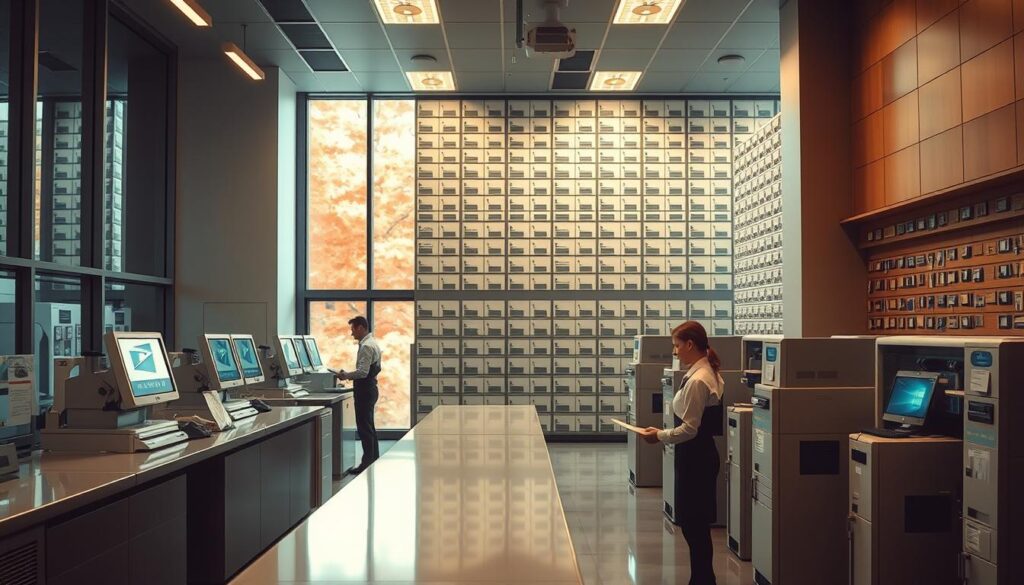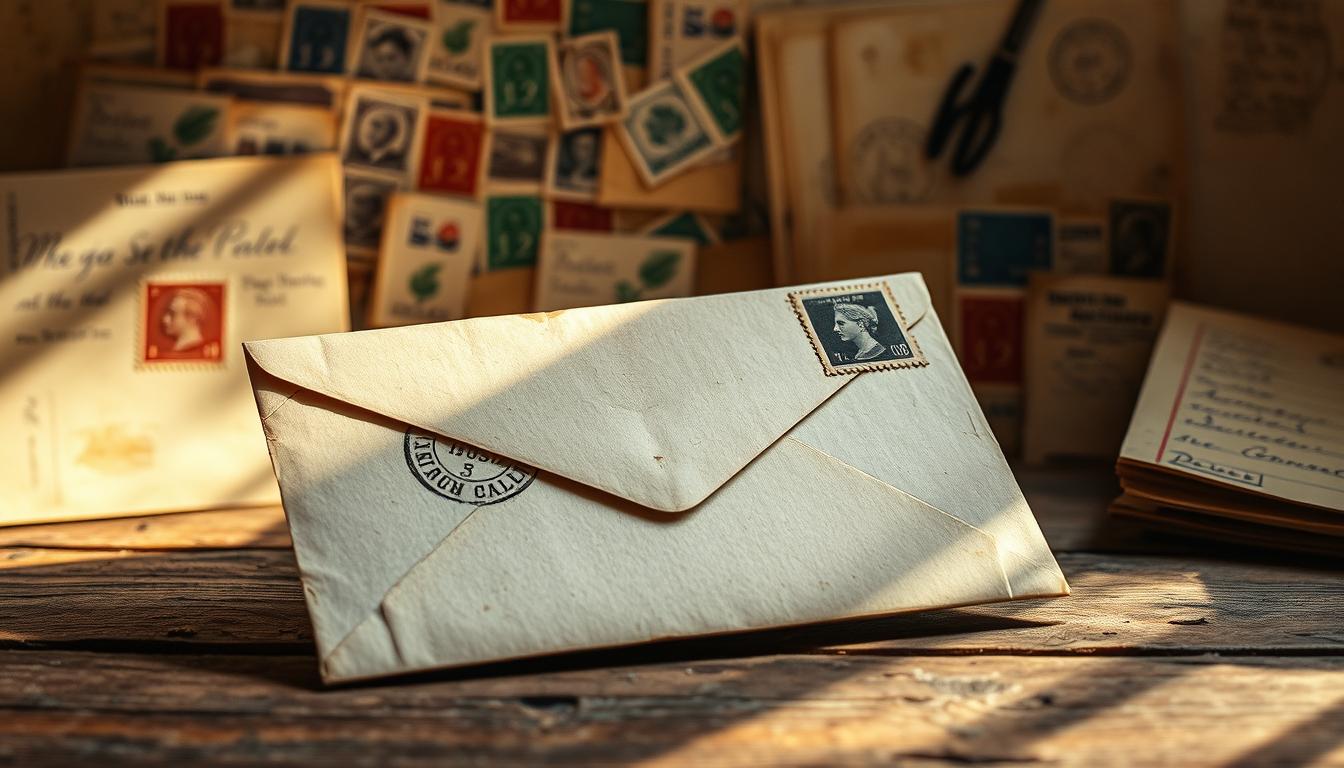The United States Postal Service has a long history of delivering mail. Recently, a letter sent over a century ago finally reached its destination. This event has amazed many and shed light on the world of postal history and delayed mail.

This letter’s journey shows the complexity of the postal system. It also highlights the importance of keeping historical documents safe. As we look into this 100-year-old letter, we’ll learn about postal history, why mail is sometimes delayed, and how these events help us understand the past.
Key Takeaways
- The letter arrived 100 years late, making it a unique event in postal history
- Delayed mail can provide valuable insights into the past and the postal system
- Historical letters are essential in understanding the social and cultural context of the time
- The story of this letter highlights the importance of preserving historical documents
- The United States Postal Service plays a crucial role in delivering mail and preserving postal history
- Understanding postal history can help us appreciate the complexities of the postal system
The Unexpected Discovery
The story of the century-old letter is truly captivating. Its discovery shows the strength of mail delivery and the postal service. The letter, found recently, has grabbed attention for its unique history. It took over 100 years to reach its final destination.
The century-old letter was found in a surprising spot. Its condition is amazing, showing the durability of mail. Despite being over a century old, it’s still in good shape. The original postmark and date are still clear, thanks to the postal service‘s care.
- The letter was found in a hidden compartment of an old desk.
- The desk had been stored in an attic for decades.
- The letter was still sealed and had never been opened.
These details tell the incredible story of thecentury-old letter and its long journey through themail deliverysystem.
A Letter’s Century-Long Journey
The story of a letter arriving 100 years late is truly amazing. It shows the incredible journey it took to reach its destination. This lost and found mail has become a famous story, touching many hearts. It shows the power of never giving up.
The letter’s journey is filled with twists and turns. It could have taken many paths, passing through different hands and systems. Its delay was caused by many things, like postal service problems and simple mistakes. But, it finally made it home, making history.
Some reasons for the delay include:
- Postal service disruptions during times of war or natural disasters
- Human error, such as misrouting or mislabeling of the letter
- Changes in postal systems and technologies over the years
This letter’s story reminds us of the value of letter-writing in our digital world. It shows us the importance of postal services. As we admire this postal feat, we also learn to cherish our history and the stories that shape our world.
Historical Context: Life in [Original Year]
To grasp the letter’s importance, we must look at the historical context of its time. The early 20th century was a time of big changes and challenges. It was shaped by events like World War I and the fight for women’s rights.
In those days, postal services were key in keeping people connected. The postal system was the main way to send messages over long distances. Letters were how people kept in touch with loved ones who lived far away.
Key Aspects of the Era
- The social climate was changing a lot, with big social and cultural shifts.
- Postal services were essential for long-distance communication.
- The historical context of the time deeply influenced how people lived and interacted.
By studying the historical context and social climate of the time, we learn more about the letter’s significance. We also see how postal services played a big role in its journey. Despite a long delay, the letter made it through, showing the importance of these services.
How Did Letter Arrive 100 Years Late?
The story of the delayed mail has caught many people’s attention. It makes us wonder why it took so long to arrive. Looking into postal history and the possible reasons can help us understand this mystery. Letters from the past give us a peek into the lives of those who lived through big events.
There are many reasons why the mail was late. Changes in postal services, lost mail, and historical events could have all played a part. For example, postal service changes might have caused the letter to get lost or sent to the wrong place. It’s also possible that the letter was lost for years before being found again. Learning about these factors can help us understand the long journey of this delayed mail.
Some possible reasons for the delay include:
- Postal route changes
- Mail handling errors
- Historical events, such as wars or natural disasters
By studying postal history and the journey of letters like this one, we learn more about the postal system. We also see how different factors can affect mail delivery. This knowledge helps us value these delayed mail cases and the stories they share about our past.
Authentication Process and Verification
Experts carefully examined a 100-year-old letter. This step is key to proving its realness and importance. They looked at the letter’s condition, paper, and ink.
Experts used special methods to check the letter’s age and authenticity. They:
- Examined the postmark and date
- Checked the paper’s texture and quality
- Verified the ink’s type and consistency
They also used historical document preservation to keep the letter safe. It was stored in a special place, away from sunlight and moisture.
Expert Analysis Methods
Experts looked closely at the letter’s physical details. They checked the paper, ink, and postmark. This confirmed its age and authenticity.
Dating Confirmation Techniques
They didn’t use radiocarbon dating. The postmark and historical context were enough proof of its age.
Historical Document Preservation
They used special techniques to preserve the letter. It was stored in a controlled environment. This kept it safe from sunlight and moisture.
The Letter’s Contents and Their Significance
The letter’s contents give us a peek into the past. They show the historical significance of the time it was written. The language and tone reveal the social and cultural norms of that era, making it a key piece for understanding postal history.
The letter contents also tell us about people’s daily lives back then. They share their struggles, hopes, and dreams. By studying the letter, researchers can learn more about the historical significance of the events and experiences it talks about.
Some important parts of the letter include:
- Personal stories and anecdotes
- Descriptions of historical events
- Insights into social and cultural norms
These parts add to the postal history of the letter. They make it a valuable find for researchers and historians.

Similar Cases Throughout Postal History
Looking into postal history, we see that delayed deliveries happen often. Many times, mail takes longer than expected to arrive. These similar cases show us the tough side of the postal system.
Exploring postal history reveals many interesting stories. For example, some letters end up in the wrong places, then turn up years later. This shows us how crucial good mail tracking is and how it needs to keep getting better.
- Mail lost in transit, only to resurface decades later
- Letters sent to incorrect addresses, resulting in prolonged delivery times
- Postal items damaged or destroyed during transportation, leading to significant delays
These similar cases show that postal history is full of delayed deliveries stories. Each one has its own story and challenges. By looking at these, we learn more about the postal system’s complexities. We also appreciate the hard work to deliver mail quickly and efficiently.
Impact on Modern Postal Understanding
Studying old mail routes helps us understand modern postal services better. By looking back, we can learn how to make mail tracking systems better. This leads to faster delivery and happier customers.
Old mail routes show how postal services have changed. For example, the Pony Express in the 19th century changed mail delivery in the US. Airmail in the early 20th century made it even faster. These changes help us build today’s mail tracking systems.
Lessons from the Past
Here are some important lessons from old mail routes:
- Adapting to new technologies and population changes is key.
- Keeping up with innovation is crucial for better service.
- Investing in good infrastructure is important for efficient delivery.
Using these lessons, today’s postal services can improve mail tracking. Combining old knowledge with new tech, like GPS, makes the postal system better.

Contemporary Mail Tracking Systems
Today, mail tracking systems are vital for fast and safe delivery. They use tech like barcode scanning and GPS. By using old routes and new tech, postal services can get even better.
Conclusion: Bridging Centuries Through Unexpected Delivery
The story of this century-old letter’s journey is truly inspiring. It shows how the postal system has stood strong over time. This feat not only connects the past with the present but also highlights the importance of historical letters.
The letter’s path, from being sent out to arriving a century later, is amazing. It proves the hard work of postal workers and the need to keep our history alive.
Thinking about this event makes us see how postal services have evolved. It shows how they keep us connected, no matter the time or distance. This delivery reminds us of the postal system’s crucial role in our lives. It keeps us tied to our past and builds bridges to our future.
FAQ
What was the surprising postal feat that occurred?
A letter was found that arrived 100 years late. This is a remarkable story in postal history.
How was the letter initially discovered?
The letter was found unexpectedly. Its condition, postmark, and date showed its long journey.
What was the letter’s journey like over the past 100 years?
The letter’s journey spanned over a century. Exploring its possible routes and delays is fascinating.
What was life like when the letter was originally sent?
Looking at the social climate and postal services at the time adds context. It helps us understand the letter’s original purpose.
How was the authenticity of the letter verified?
Experts used various methods to check the letter’s authenticity. They confirmed its date and ensured its preservation.
What were the contents of the letter, and what is their significance?
The letter’s contents offer insights into the past. They show the importance of understanding historical events.
Are there other similar cases of delayed mail deliveries throughout history?
Yes, there are other stories of delayed mail. They give us a broader view of postal history.
How can this historical postal feat inform modern postal understanding?
Learning from historical mail routes and delays helps us today. It teaches us how to improve mail tracking and postal services.
